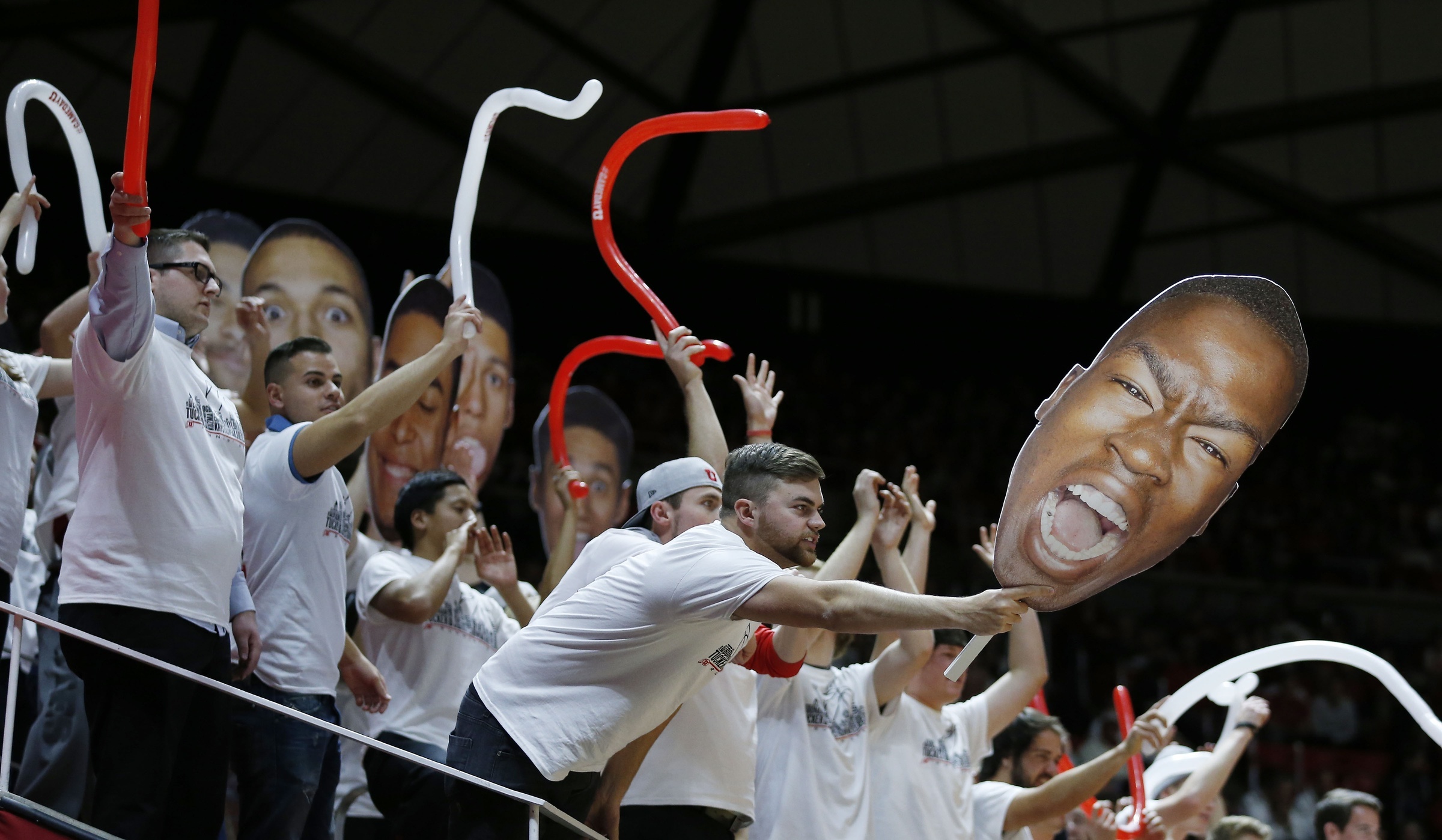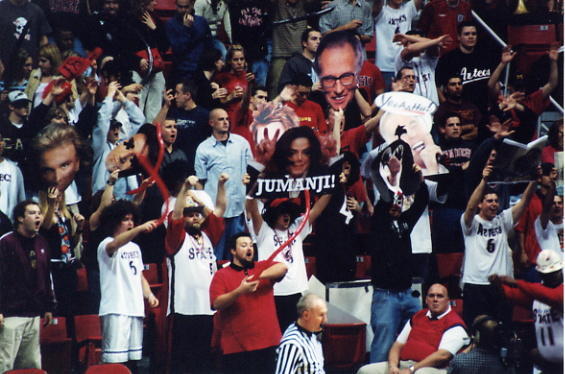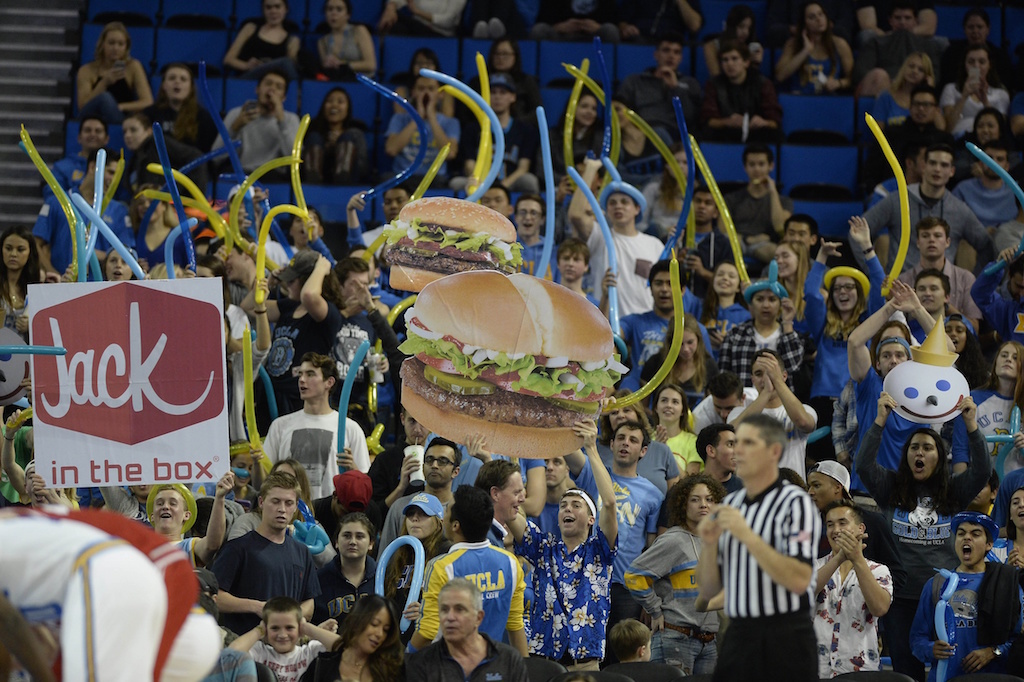I approached the large head of Dave Leitao with the appropriate reverence. It was Christmas Eve eve, in 2011, and I was at a D-League game between the Maine Red Claws and the Iowa Energy; Leitao was the head coach of the Red Claws, which explains why there was, in the bleachers behind one of the baskets in the Portland Expo, a jumbo rendering of Dave Leitao mounted on a stick. Other faintly recognizable disembodied faces were scattered throughout the section: Red Claws assistant Donyell Marshall’s distinctive sleepy-eyed mug, the poker face of former St. John’s star Justin Brownlee, and a grinning image of Kenny Hayes, a scoring guard from Miami University of Ohio who is now playing for a Turkish team called Demir İnşaat Büyükçekmece.
My instinct where these giant heads were concerned was strong, if also strange: I wanted to bring one of them home, back to my in-laws’ and then eventually back—on a plane, I guess, somehow—to my own home. I knew this was wrong for a number of reasons, that doing that would be unethical and impractical and quite possibly logistically impossible, and that it would also probably bother my in-laws. I settled for a photo with Leitao’s giant head. I am not by nature given to theft, or even to fantasies of theft. It’s just that I loved the enormous faces so much.
Videos by VICE
Read More: “Spreadsheets Are Dope,” Or The Allure Of The DIY College Basketball Fantasy League
There has never been a bad time for Oversized Disembodied Heads at basketball games, if we’re being honest. Since a San Diego State fan named Conor Mongan waved the first one—an image of Michael Jackson during his turn-of-the-millennium Ghost In Disguise phase—during an Aztecs game against Long Beach State almost 15 years ago, people have recognized the weird power of the Oversized Disembodied Head. But while what Mongan calls “the whole big head thing that I started” can be traced to a specific place (it was called Cox Arena then, and is Viejas Arena now) and time (while Long Beach State’s Darnell Thompson prepared to shoot a free throw with a little over 11 minutes remaining in the first half on December 12, 2002), it’s hard to pinpoint its high-water mark.
There is a sense, though, that it is already behind us. It’s not that Oversized Disembodied Heads, which we should probably just call ODHs in the interest of brevity, have stopped showing up at college basketball games. Nor are they somehow less distracting or amusing in their intended ways; it’s hard to imagine a future in which it will not be startling to be abruptly and inescapably confronted with a full-color four-foot rendering of, say, Larry King’s face. It’s just that ODHs are no longer new; they have faded into the manic background from which they emerged, and become part of the broader landscape of college basketball’s signature all-encompassing overage. They are a thing of beauty, forever and always, but they also exist in a strange place at the moment. What happens to a meme, really, in its middle age?

Yes, even in Utah. Photo by Jeff Swinger-USA TODAY Sports
Here is the creation story, as it is generally told. The Show is a fan community at San Diego State whose existence goes back to 2001, and is still a presence at Aztecs games. It was as a member of The Show that Mongan broke out that first big head, and whether it was because of the jarring presence of a gigantic leering homemade Michael Jackson or not, two missed free throws ensued. Two missed free throws and many hundreds of heads.
Mongan’s innovation was soon shared widely among members of The Show, who made the heads a central part of their in-game routine. “Gene Simmons (with a realistic waving tongue) and Siegfried & Roy, were first up,” the “lore” section of The Show’s website explains. “As the numbers grew, so did the looks from the opposing players and bench, as well as free throw misses. So more were made, primarily a collection of quirky celebs like Chris Farley, Conan O’Brien, Larry King, Chuck Norris, Richard Simmons, and Emilio Estevez.”
In his 2013 piece on the rise of the ODH in Sports Illustrated, George Dohrmann traces the rapid national spread of the big head back to a photo of The Show that appeared in a December 2005 issue of ESPN The Magazine. “In that photo,” Dohrmann writes, “no less than nine heads are visible.” People with positions of authority in various athletic departments saw those heads—they included Lil Jon and a SDSU message board personality named “Aztec Joe”—and moved to replicate the ODH idea in their home gyms.
Marquette’s assistant athletic director for marketing found a local sponsor to print the heads, and it took off. When Indiana hired Tom Crean away from Marquette, he brought the ODHs with him to Bloomington; Crean is an ardent and public fan of the big heads. When the assistant AD was hired by Louisiana State and then Oregon, the ODHs went there with him. “Viral” is the most obvious word for it, but also the most appropriate: a few carriers introduce something new into a population that is, in this case, the opposite of immune where ridiculous ideas are concerned.
It seems wrong to describe the wildfire wave of the ODH as an epidemic, but it’s the grimness of the metaphor that doesn’t fit, not the fact of how it all worked. By the time Dohrmann wrote his story about ODHs, the big heads were everywhere; a nation of charged-up college-age goofballs caught the same benign spirit of collective absurdity and then proceeded to raise the stakes on itself, repeatedly and furiously. There were industries large and small dedicated to producing and selling the heads. That was four years ago.

The Show, circa basically anytime in the last 15 years. Public Domain Image via Wikimedia Commons
“I still have the original one in my parents’ house,” Conor Mongan told me. He was referring to the first Michael Jackson ODH that he held up against Long Beach State all those years ago. “It’s autographed by like the 2005 [San Diego State] basketball team. The photo was from one of the court appearances. It was a super-weird time for Michael Jackson. And his nose had like weird bandages on it?” He offered to send me a picture of it and I said yes; I can confirm that it is indeed profoundly hideous. “I keep waiting for someone to call me and take it and put it in a hermetically sealed airtight chamber.”
Mongan is from San Diego and attended San Diego State before he “went pro early” and moved to the Bay Area to work in graphic design. He came back to San Diego several years later; when he joined up with The Show during its early days, he was a non-student. “To be honest,” he said, “when we were getting started there weren’t that many students going to the games. And where we were situated, it was right by the opponent’s bench. So we just kind of had free reign, and had all this room to ourselves to jump around and act like idiots. The allure was kind of the impact that you could have on the games, because it was so sparsely attended.”
Mongan’s contribution to the long tradition of fans trying to make things weird for the visiting team unfolds like basically every other cool thing in the culture, with young people messing around and being creative and trying to amuse and impress each other with acts of avant-garde dumbness. It was not just a DIY process but something like an artisan one; Mongan made the prints at Kinko’s and assembled them himself. “Back in the day,” he said, “there would almost be like an audible gasp or a cheer when we’d unveil a new one, because there was this element of surprise. I’d just like, roll in from Kinko’s and no one really knew what it was going to be. It was this cool time period where we just kind of had freedom, creatively, to pump out the weirdest stuff possible.”
As the idea grew up and out from San Diego, it didn’t so much change as grow up. Some of this was simply the result of the world recognizing a good idea well executed; University of Alabama student Jack Blankenship parlayed an ODH he made of his own cartoonishly scowling face into an internship at The Tonight Show, which later became a job as a researcher. In February, Blankenship was on the show himself, playing The Jackson Five’s “I Want You Back” on a harmonium, through his nose.
For the most part, though, the ODH aged into something familiar. Schools printed and distributed their own signs, then collected them at the end of games when they could; these were funded by line items in the athletic department’s marketing budget. A 2010 story from the Times of Northwest Indiana tells of how IU marketing director Pat Kraft found a way to make the school’s ballooning ODH budget work: Fifth Third Bank sponsored the heads, offsetting nearly all of the cost. One concession was that a Fifth Third credit card wound up in the rotation of disembodied heads, bobbing around at games next to Andre the Giant and Tom Crean. A company called Build-A-Head still maintains an online business in making ODHs—prices start at $14.99 for a 12×18 head on a stick; the three-foot “Giant Head Cutout” is $49.99, marked down from $54.99 for the season—but wound up getting bigfooted into a niche once Fathead and its passel of official licenses and chairman (and Cleveland Cavaliers owner) Dan Gilbert’s cash got into the game. As Fathead CEO Patrick McInnis put it to Dohrmann, “There have been other companies who have been doing [big heads] for awhile. But we made our heads obnoxiously big.”

The famous spontaneity we love to know. Photo by Richard Mackson-USA TODAY Sports
To a certain extent, this is just how this sort of thing goes, and the free market doing what it does. It’s not that the number of Oversized Disembodied Heads has diminished, or that they’ve lost their undeniable uncanniness or unverifiable effectiveness. It’s that, as they have expanded and grown and expanded and grown, they have receded into a familiar sort of recursiveness. The original absurdity has flattened into the familiarity of the over-humped meme—something that exists primarily to be recognized. The first person who holds up a funny sign behind the talking heads on College GameDay is doing a great service to the universe. What would you say that the 350,000th person is doing?
Mongan admits that there was a period of time, during the first viral bloom of the ODH moment, when he was angry and jealous about seeing an idea that he thinks of as his, and more broadly that of his fan crew, spreading so far and so heedlessly. “And then it just became so oversaturated that I didn’t have the emotional capacity for that amount of jealousy and rage,” he says, “so I kind of just let it go.” Still, he has some misgivings about what’s come after the original ODH gold rush. “All the initial ones were just very bizarre, like B- and C-level actors, just the worst photos possible of all these people,” he says. “The disappointing thing is that as it’s evolved it’s just turned into like a glorification showcase—like the best player on the team, or the coach. It feels like just another way to get on TV.”
Mongan moved to Austin and runs a photo-booth business—”an experiential marketing firm, that’s the fancy way to say it”—called SUM Booth. He sees the heads on TV, because he watches basketball and because they are still everywhere. “To be honest,” he says, “I don’t feel anything. I’ve almost come to expect that if I turn on a college basketball game, it’s almost weird if you don’t see one in the crowd. I’ve just grown to accept that it is part of the fandom landscape at this point.” He did not sound angry, or even really all that sad. He just sounded like someone talking about the world in which he lives.
Want to read more stories like this from VICE Sports? Subscribe to our daily newsletter.




